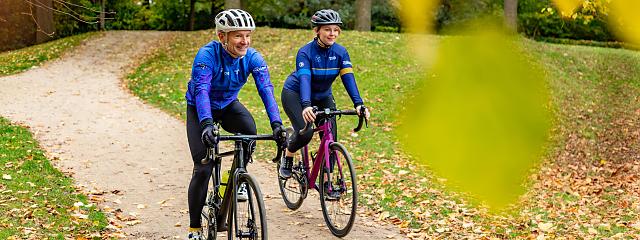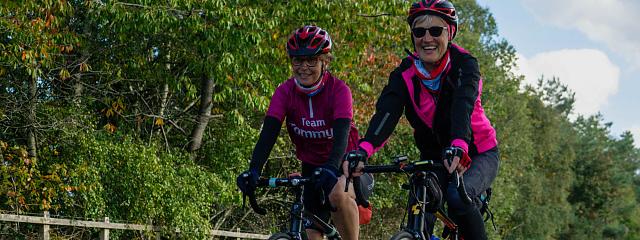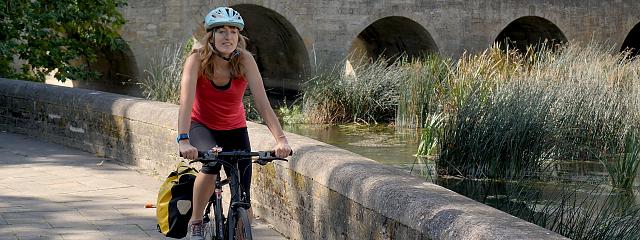
Charity rider FAQS
Charity rider FAQS
- What types of insurance is there and which do I need?
- How do I stay safe at an event on open roads around other cyclists?
- What size tyres will fit on my bike?
- How do I pack, protect and dismantle my bike for travel to an event?
- How do I repair a puncture?
- How do I plan or find a cycling a route
Buy Cycling UK 6 month membership
What type of insurance is there and which do I need?
Third-party liability insurance
By joining Cycling UK, you’ll automatically receive £10m third-party liability insurance provided by Butterworth Spengler Insurance Brokers. This will cover you if you damage another person or their property; for example, if you were to accidentally cause injury to a fellow rider or hit a car.
Legal assistance
Cycling UK membership includes access to our personal injury incident line on a no-win, no-fee basis. Our legal partner Cycle SOS does not charge a success fee, so members keep 100% of any compensation.
Cycle insurance to cover theft and damage
Cycling UK members also get exclusive deals on cycle insurance with Yellow Jersey, or a specialist combined bike and home insurance policy with Pedal Cover. This insurance protects your bike if it gets stolen or damaged. To talk through the best cover for your home and/or bike to protect it against theft or damage .
Travel insurance for cycling
If you’re taking your bike on a longer holiday or short trip to do a charityt ride, your standard travel insurance policy may not specifically cover cycling. Cycling UK members receive 15% discount off policies with specialist cycle travel insurers Yellow Jersey which crucially includes medical expenses should you have an incident abroad.
How do I stay safe at an event on open roads around other cyclists?
- Abide by the Highway and Countryside Codes – never ride more than two abreast except when passing. Shout ‘Passing!’ if you do.
- Drop into single file on narrow or busy roads, unless it would be unsafe to do so.
- Show courtesy to other road and trail users and be a good ambassador for cycling.
- Be alert to what other riders around you are doing and don’t get too close to them.
- Shout ‘Slowing!’ or ‘Stopping!’ if necessary – smooth, gentle manoeuvres work best
- Point out any road defects or other hazards to others
- Hold your line- make sure you are riding straight along the road and if turning keep a smooth line rather than suddenly veering out too wide. Staying straight and being predictable with your movements will help avoid any potential collisions with other road users.
- Make sure your road positioning is correct, if you aren't sure we have a helpful article explaining road positioning.
- Protect your front wheel and give other cyclists around you space, if your mind wanders your bike might also start to drift forward overlapping your front wheel with the rear wheel of a rider in front of you. If that rider suddenly swerves this will cause a domino effect with you ending up on the ground, and the potential to take out more riders behind you too, so pay attention and protect your front wheel. Give riders infront of you a decent amount of space.
- Practice makes perfect- why not join a local group ? They will help you grow in confident with group ride etiquette out on the roads and make training for your charity ride more fun too.
What size tyres will fit my bike?
Cycling UK’s article about tyre sizes has a handy formula for matching tyre widths to rim widths: the ideal ratio is roughly 1.8 to 1.
So a 23mm tyre is just right on a 13mm rim (13×1.8=23.4).
Tyre and wheel size is also limited by the space available in the bike’s frame, fork and mudguards.
To get an idea of whether a different size will fit, check the tyre’s listed ISO width – and for different wheels, the radius (half the overall tyre diameter) – against the gaps in your bike’s frame, fork and mudguards.
Tyre tips
ISO tyre diameters are reliable but widths vary; some 32mm tyres, for example, are narrower than others. To determine a tyre’s exact width on a particular rim, you need a Vernier calliper to measure it.
Tubeless tyres use wider rims. The ratio of tubeless tyre width to rim width may be significantly different from 1.8:1.
Tubeless rims and tyres can be stubbornly tight fitting. They need to be so they don’t ‘burp’ air and sealant. To go tubeless, tyre and rim must both be tubeless ready. If either or both aren’t, stick with inner tubes.
Recommended pressures
All tyres are marked with a pressure. Sometimes this is an absolute maximum that nobody should need to exceed, Do not exceed the maximum when tyres are marked with a range.
How do I pack, protect and dismantle my bike for travel to an event?
Some kind of case is often required when taking your bike abroad, you need to put your bike in a box or bag for plane travel and it can be required on some rail services particularly in Europe. Do check any regulations for the size limited carefully before booking your travel. We have rounded up the best bike bags and boxes in our Group Test with prices ranging from £56.99-£520 to help you.
Shipping your bike ahead of an event? How do you ship a bike safely without it getting damaged on the way? This simple step-by-step guide details how to box up a bike, including the materials you need and the best techniques for dismantling your bike.
Tools required:
- Allen keys
- Adjustable spanner
Packaging materials required:
- Bubble wrap
- Cable ties
- Foam tubing
- Packaging chips
- Large, triple ply box big enough for the bike frame
The process:
- Find a strong box that is big enough for your bike. You can find boxes for bikes at most bike stores, and they are normally free. The box needs to be large enough to fit the bike and the different parts you will be removing. A specialist bike box, or a triple ply box would be best suited.
- Remove any accessories, including lights, water bottles, speedometers and mudguards.
- Remove the pedals by turning the bolt of the right pedal counter-clockwise with your wrench, and vice versa for the left pedal. This is needed so your bike fits more easily into the box.
- Shift the bicycle chain onto the small chain ring and largest rear cog.
- Loosen and remove the seat post and seat as a unit. Once removed, re-tighten the seat post bolt so the seat does not fall out. If your bike is older, just unscrew the bolt or nut that is used to keep it in place and lift the seat from the frame.
- Time to remove the front wheel. Thankfully, this is a simple job, especially if you have quick release bolts. Undo this and then slide the wheel through the brake blocks and set the wheel to one side. Don’t forget to let some air out of both tyres – particularly important if your bike is travelling by air.
- You will now need to remove the handlebar. Most modern bikes allow you to remove the handlebar only. Simply remove the bolts from the stem face plate to detach the handlebar, keep the brake and gear cables as they are and slowly lower the handlebar, turning it vertically so it slides down by your front forks. If you have an older 'quill' system it is easier to remove the handlebars and quill stem as one by simply undoing the stem bolt. After removing the handlebar, rotate the fork and stem so they are facing backwards.
- Wrap the frame and handle bars in foam tubing. You can use normal foam layers by wrapping them around a couple of times.
- Fill the bottom of your box with two inches of bubble wrap or packaging chips. Then lift the frame and place inside of the box and fill all remaining space around it with packaging chips or bubble wrap. Remember to keep attached de-assembled handlebar still vertical. Now you can place the front wheel down the side of the box and remember to put all your bolts, screws and accessories in as well (secured in a separate box or bundled together in a plastic bag). Separate the main bike frame from the wheel and accessories with packaging chips and bubble wrap.
- Secure your box with plenty of packaging tape. Make sure to wrap all seams in three layers of tape and then layer tape 3 times in a vertical and horizontal fashion around the box. You then need to clearly attach the shipping labels to the box and arrange for the pickup and delivery of your bike.
This guide was written for Cycling UK by Parcel Hero.
How do I repair a puncture?
Watch these step by step videos on how to repair punctures and do basic roadside repairs. Make sure you carry a pump, innertube and bike repair kit with you and you know how to do the basics.
How do I plan or find a cycling route?
You can plan a route using Cycling UK's Journey Planner or check out our published cycle route guides in your area. Plus we have over 150 great routes to inspire you to explore further afield on the routes area of our website.












